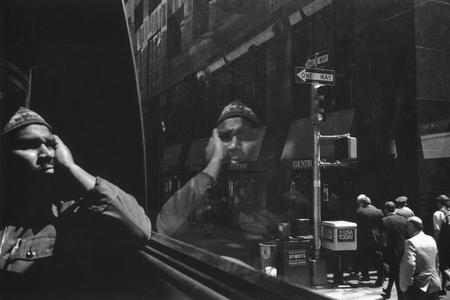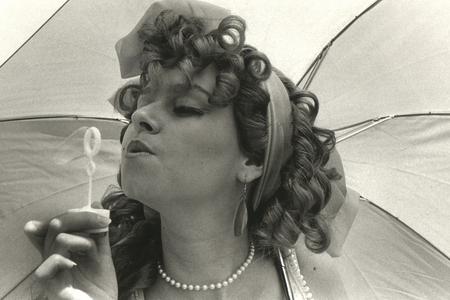
The work of photographer and Brooklyn native Harvey Zipkin to appear in
upcoming photography The Exhibition at Brooklyn Museum.
“When I do a documentary I get right into the peoples’ faces while I talk to them…Taking a picture of someone five miles away with a telephoto lens…I just don’t think, I mean…that’s not photography.”
By Palmer Hasty
Brooklyn native and well known photographer Harvey Zipkin (www.harveyzipkin.com) currently lives in Boynton Beach, Florida. He is a resident artist at the Bakehouse Art Complex in Miami (http://www.bacfl.org/), teaches special photography classes at the Jose DEdiego Middle School, and of course, continues to sell his photographs.
Many of Zipkin’s photos reside in the permanent collections of over 20 museums across the United States. To mention just a few: The Brooklyn Museum, The Library of Congress, The Smithsonian American Art Museum, The Museum of the City of New York, The New York Transit Museum, and The Museum of Photographic Arts in San Diego, California.
In fact, several of Zipkin’s photos can be seen in the upcoming exhibition at the Brooklyn Museum that starts November 20, and runs through March of 2016. The exhibition, titled “Forever Coney”, will include several of Zipkin’s famous photographs from his documentary series titled “Coney Island Revisited”.
The Brooklyn Eagle recently published an article about the New York Transit Building at 370 Jay Street (” ‘The Secret Life of 370 Jay Street’ to be Revealed in Downtown Brooklyn”). Zipkin had a critically acclaimed solo exhibition in the Transit Museum on Jay Street back in 1998 titled “Personally I Don’t Like Cabs”, and several of those photographs can be viewed in the Transit Museum’s permanent collection.
In a recent interview with the Brooklyn Eagle, Zipkin talked about his work and revealed some of his childhood memories growing up in the Bensonhurst section of Brooklyn.
BE: So where were you born?
HZ: I was born at the Israel Zion Hospital in 1942, and my family lived on 79th Street and 18th Avenue in Bensonhurst. We lived there until I was 12, when the family moved to Long Island.

BE: Tell us some things you remember about growing up in Brooklyn?
HZ: “When I was a kid I thought everybody in the world lived in Brooklyn.
We had a one bedroom apartment in a two family house. We had a big closet we used to go into and develop film and print pictures. My brother and I shared a foldout couch in the dining room.
It was a great thing growing up in Brooklyn, the neighborhood was phenomenal, everybody knew everybody.
We played stickball all the time…at school against a concrete wall and in the streets where you had to hit it past two manhole covers for a home run. We built go-carts out of wooden fruit boxes and two-by-fours, and used old roller skate wheels.
BE: Didn’t you say your wife was born in the same hospital as you?
HZ: “Yes. When I was born my mother Ruth happened to be a good friend of my wife’s aunt. My wife’s aunt took her sister (my future mother-in-law) to see her friend Ruth’s new baby, which was me. A few years later my future wife was also born at Israel Zion.”
BE: So you had already made a good impression on your mother-in-law?
HZ: (Laughing) “I guess so.”
BE: When did you decide to be a photographer?
HZ: “When I was around 20 years old. I was working in the arts supply business in Mahnattan with my uncle. We had to deliver some mounting board to the International Ladies Garment Workers Union. I met the head photographer for the ILGWU, Burton Berinsky. I got interested in photography again. It was through Berinsky that I met the master photographer and printer Philip Perkis. I remember Perkis told me: ‘Young man, if you want to be a photographer you learn from the darkroom.” Perkis eventually became the Chair of Photography at Pratt Institute. Both Perkis and Berinski were mentors and instrumental in my decision to become a professional photographer.”

BE: What kind of camera do you use?
HZ: I’ve been using a Leica camera most of my life. When Leica developed a full frame digital camera I went over to digital because it was easy to work with.
What application do you use now to produce your digital photos?
I use Adobe LightRoom more than anything else…I use one lens all the time…I don’t use a zoom lens, nor a telephoto lens. I still use a 35mm lens because that’s exactly the way you see with your eyes. When I do a documentary I get right into the peoples’ faces while I talk to them and try to get a little history about them when I photograph them. Taking a picture of someone five miles away with a telephoto lens…I just don’t think, I mean…that’s not photography.”
BE: What exactly are you doing in Miami now?
HZ: “In addition to having taught photography at the Jose DEdiego Middle School, and the having a residency at Bakehouse Complex, all I’m doing is photography, period!
I’m currently doing what I like most; documentary photography. I’m documenting the Hispanic area of Wynwood in Miami, before it becomes completely upscale and gentrified.
A lot the people are being displaced and moving out. It was basically a Puerto Rican community with some Dominican and Cuban families. It’s changing constantly…When I walk through a neighborhood its never the same.
That’s what I teach my students…life is never the same. You can go to the same place a hundred times and it will always be different. You’re lucky if you shoot 500 pictures or a thousand pictures, and then find one that you really, really like.
So I’ve been documenting the area and the changes for the past two years.”
BE: It appears that some of your most iconic photographs came from that type of long term documentary approach where you would spend several years working a theme.
HZ: Exactly. The New York City transit bus series in the 1990s and my Coney Island project in the late 80s.
My grandmother and grandfather used to take me to Coney Island…my grandfather used to take me to a Raven Hall Bathhouse for a steam bath and massage, then we’d walk along the boardwalk and eat steamers (steamed cherry stone clams) and on the way home we’d stop at the bar so he could have a Schnapps before we went home to my grandmother. When my grandmother took us there we’d sit under the boardwalk cause she didn’t want to get too sun burned. We went to Steeple Chase but not often because it was too expensive. Of course we always went to Nathan’s for hotdogs, pork sandwiches and French fries…that was the treat.
I must have spent three years going back and forth to Coney Island. I would do the Mermaid Parade one year and document it the next year. Coney Island is different every time you go there. You always see different things.”

BE: When you were starting out what was it like for an unknown photographer in New York to meet the well known Brooklyn Museum Curator Barbara Millstein for the first time?
“I have a great relationship with the Brooklyn Museum. I have about 7 or 8 photographs in their collection, they’re using some of my images in that show on Coney Island next month.
About Barbara Millstein. Well, what happened was…she was the photography curator the Brooklyn Museum and was famous in the art world, known to be a very tough old lady, very tough. I called her directly and said I’d like to have an appointment to show her my work. She said, ‘Did you ever have a show?’, and I said, ‘Yea, I’ve had a show’.
At that time I had only had a show in a library or something.
So she said, ‘OK, come up and see me.’
So I went there with a portfolio. I didn’t even know how to present a portfolio. So I’m carrying this huge portfolio filled with mounted photographs and its summer and I’m sweating like a pig and I go there and the receptionist says ‘Miss Millstein will see you now‘.
I walk in and she’s on the phone with another photographer…I hear her yelling at him…’Your work stinks, you stink, and I don’t ever want to hear from you again., don’t bother me’, and she slams the phone down.”
(Zipkin starts laughing)
So I’m walking in there for the first time and my knees are shaking.
So she says…’What do you have for me?‘
I laid my portfolio on the table and she’s looking at the pictures and spending about twenty minutes on each picture, holding them up to the light; ‘This one I like, that one I don’t like’…and then she said, ‘I don’t buy anything from anyone at the beginning but I want you to come back, I really like your work.’
I had said to her that I was in my forties and have been a photographer for a long time and asked her if I should continue, or get a day job, and she said … ‘I rarely see work of this quality. I really like your work.
I want you to come back and see me.’
All photos Courtesy of Harvey Zipkin.